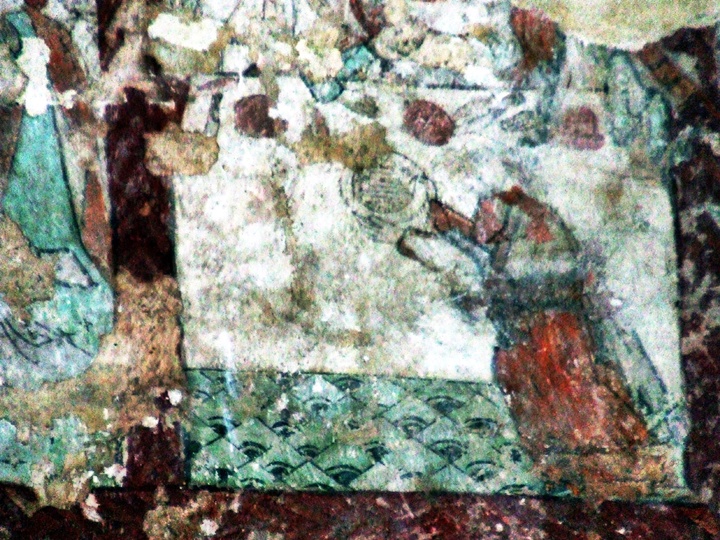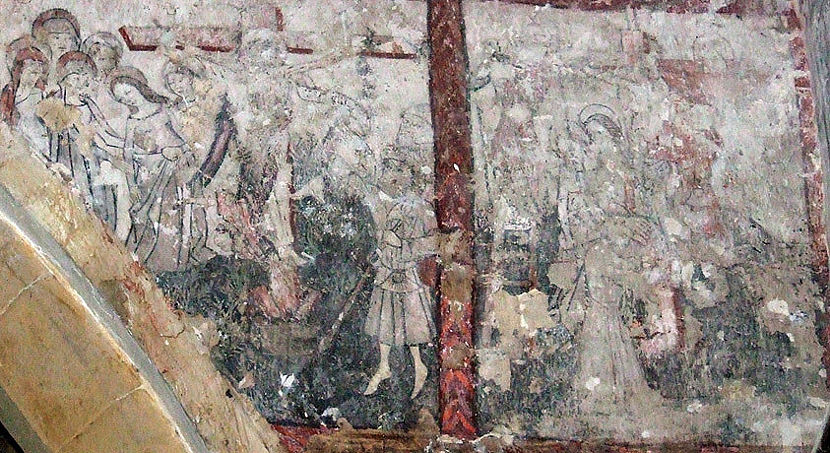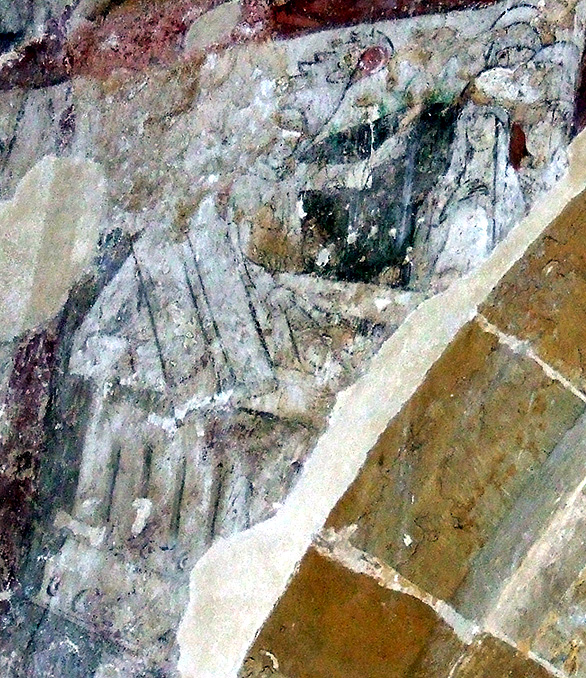Ashby St Ledgers, Northamptonshire (†Peterborough) C.15
Scenes from a Passion Cycle

This Passion Cycle is actually one of the most remarkable and detailed I have seen in an English church. It is not easy to see, though, and it is rendered less so by the heavy illusionistic border, painted in reddish brown, that divides the individual scenes.
The first identifiable scene is the Last Supper shown at the left. The meal itself seems to consist of fish and bread, with fish on a platter held by a serving woman in a red kirtle who reaches across the table from the right. More fish, along with loaves and a knife, are visible on the table itself. The green floor tiles have the kind of pattern still to be seen in some ancient churches.
There is a confused scene to the right of this one which may be the Mocking and/or Buffeting of Christ Reasonably well-preserved below the horizontal border below the Last Supper are the Crucifixion and Deposition.

The Crucifixion, at the left, is a very detailed scene, with a group of women, among them a fainting Virgin Mary, standing beside the Cross on which Christ hangs. To the right of the Cross stand at least two, probably more, male figures, prominent among them the Roman centurion of Luke 23:47 who pronounced Christ a ‘righteous man’. He seems to be the foreground figure (sometimes identified as Longinus) with a purse on his belt and a long spear. He seems to be raising his right arm towards Christ, and I think a faint speech-scroll may once have had the quotation from Luke. This entire scene is very gracefully painted.
The right-hand panel, beyond the red divider, shows a very faint and confused Deposition. It is hard to isolate details, but a ladder with a figure on it is visible at the far left. The two thieves still hang from their crosses, as indeed does Christ himself, although the centre of the panel shows a man in a long robe (Nicodemus, probably) helping to take him down, while the Virgin Mary cradles him in her arms in a posture familiar from paintings of the Pietà. At least, that is what seems to be intended as the dead Christ lies across Mary’s knee. Several post-Crucifixion ‘moments’ have been compressed here.

Two more scenes follow, one of them identifiable as the Resurrection, with sleeping soldiers, but both of them otherwise too damaged and unclear to show here. The three Maries at the tomb, shown below is in a slightly less dilapidated state. Reading from the right, three female figures and one man with a just-visible tonsure, identifying him as Peter, stand looking down into a rectangular table-tomb with what look like discarded grave-clothes inside it. Behind the tomb stands an angel, (he once had fine upraised wings, but these have largely disappeared) one arm flung out towards the women, the other indicating the grave-clothes (‘he is not here, but is risen…’ [Luke24:6]). The pushed-aside lid of the tomb slants across it. This is, as so often, a scene from a late-fourteenth or fifteenth-century churchyard. which at least helps to date the painting.
Trying to isolate any further scenes from this Passion Cycle has defeated me so far, but the church itself has an excellent website which includes a small photograph of the Entry into Jerusalem. Follow this link to see it.
Two other wall paintings at Ashby St Ledgers, a Martyrdom of St Margaret and a particularly appealing St Christopher have been on this site for some time. The church, which is obviously cherished by its parishioners, is open every day. More Passion Cycles in English churches are in the table below.
Website of the Blessed Virgin Mary & St Leodegarius, Ashby St Ledgers
† in page heading = Diocese